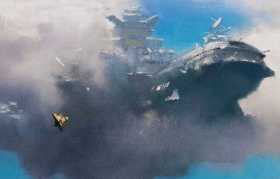
For your celebratory mask-making ceremonies, you can and should design your own wild woman images. You can also choose from a list of classical goddess images, such as:
-
Peacock Woman is Juno, whose totem is the royally plumed bird
 PaganSquare.com - WitchesAndPagans.com
PaganSquare.com - WitchesAndPagans.com PaganSquare is a community blog space where Pagans can discuss topics relevant to the life and spiritual practice of all Pagans.

[Continuing our series of interviews centered around Myths, Moons, and Mayhem, we sit down for a Fast Five with author Greg Kosebjorn.]

...

How do you get modern audiences to connect with mythology? How do you reinvent a classic but obscure comic book character? And can a video game adaptation of one of the internet's quirkier creative works capture its original appeal? These are just some of our stories for Airy Monday, our segment about magic and religion in popular culture. All this and more for the Pagan News Beagle!
Hello, and welcome to my new blog “Myth Maker: Modern Mythopoeia.”
In the next post, I’ll get to the meat of this blog, introducing you to a variety of lesser-known spirits from around the world and telling you the stories and teachings they tell to me. But I thought I’d start off by talking a little about mythopoesis as an art and a magical practice. The English word mythopoesis comes from the Greek μυθοποιία, and literally means “myth-making.” The second part of the word, “poeia,” is the root of our word “poet.” Historically, the word was an obscure technical term, describing, as Victorian historians would tell it, that period of time when humans made myths “instead of science” to explain the world around them. However, in 1931, J. R. R. Tolkien (author of The Lord of the Rings) published a poem titled Mythopoeia, which was a direct response to his frenemy and Oxford colleague C.S. Lewis’s skepticism about the value of myth. Lewis (at the time, although his views softened with the wisdom of age) believed that myths are "lies and therefore worthless, even though 'breathed through silver.”' Tolkien's poem replies...

Dragons of the Cosmos are a part of the fabric of the Universe. According to many myths, these Dragons have either created the world or plotted to destroy it. They have an intense unbounded energy to accomplish their aims. Because of the danger They pose, these dragons are best to be avoided. Moreover, Cosmos Dragons only have relations with the Gods, and usually ignore humans.
The Great Mother Dragon, Tiamat of Babylon (pictured above) is one of the best known of the Cosmos Dragons. As the Creator, She formed the first Heaven and Earth with Her Body. Tiamat is also called the Lady of the Primeval Chaos, who avenges her spouse’s murder. According to Babylonian myth, She tried to rid the Earth of both Gods and humans, and nearly succeeded.
...
To understand dragons better, people have commonly divided them into various families. As with scientific classification, organizing dragons into groups gives folks a framework to learn about them. By studying dragons in families, you can discern who are friendly and who are dangerous. Since each family has their own unique talents, they can also offer their matchless wisdom to seekers.
In Western Tradition, dragons are usually grouped into families by the elements. I have used that system to construct my classifications of dragons. Living in the East, the Dragons of the Air ride the winds. Meanwhile, the Dragons of Fire reside in fire, and are of the South. In the West, the Dragons of the Waters frolic in the waters. With the Air Dragons and Ice Dragons, Water Dragons rule the weather, as well. Ruling the Earth and guarding its treasures are the Dragons of the Earth, who reside in the North. Because each dragon family governs a cardinal direction, therefore in rituals a seeker can avoid the hostile ones and ensure her safety.
...